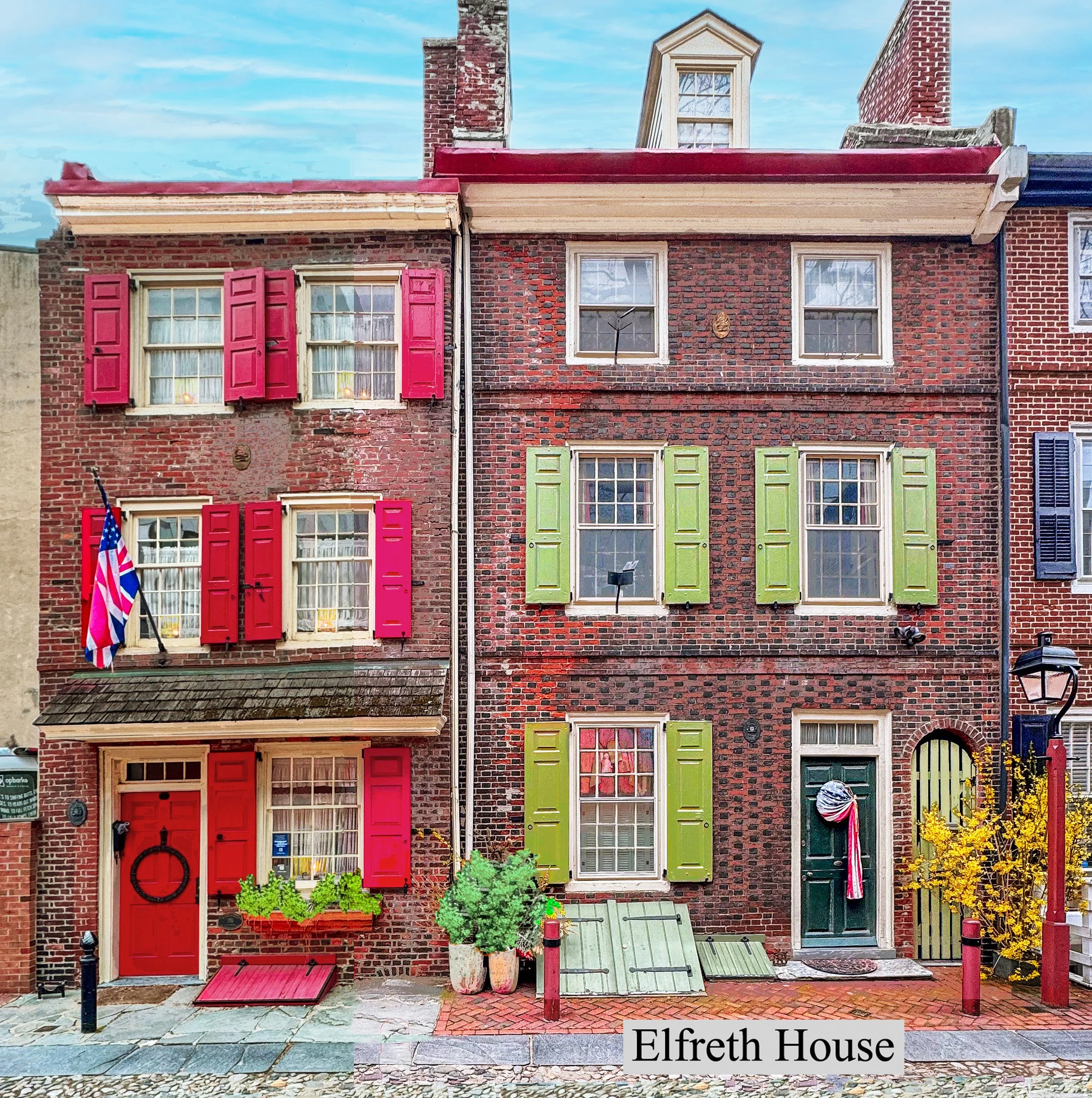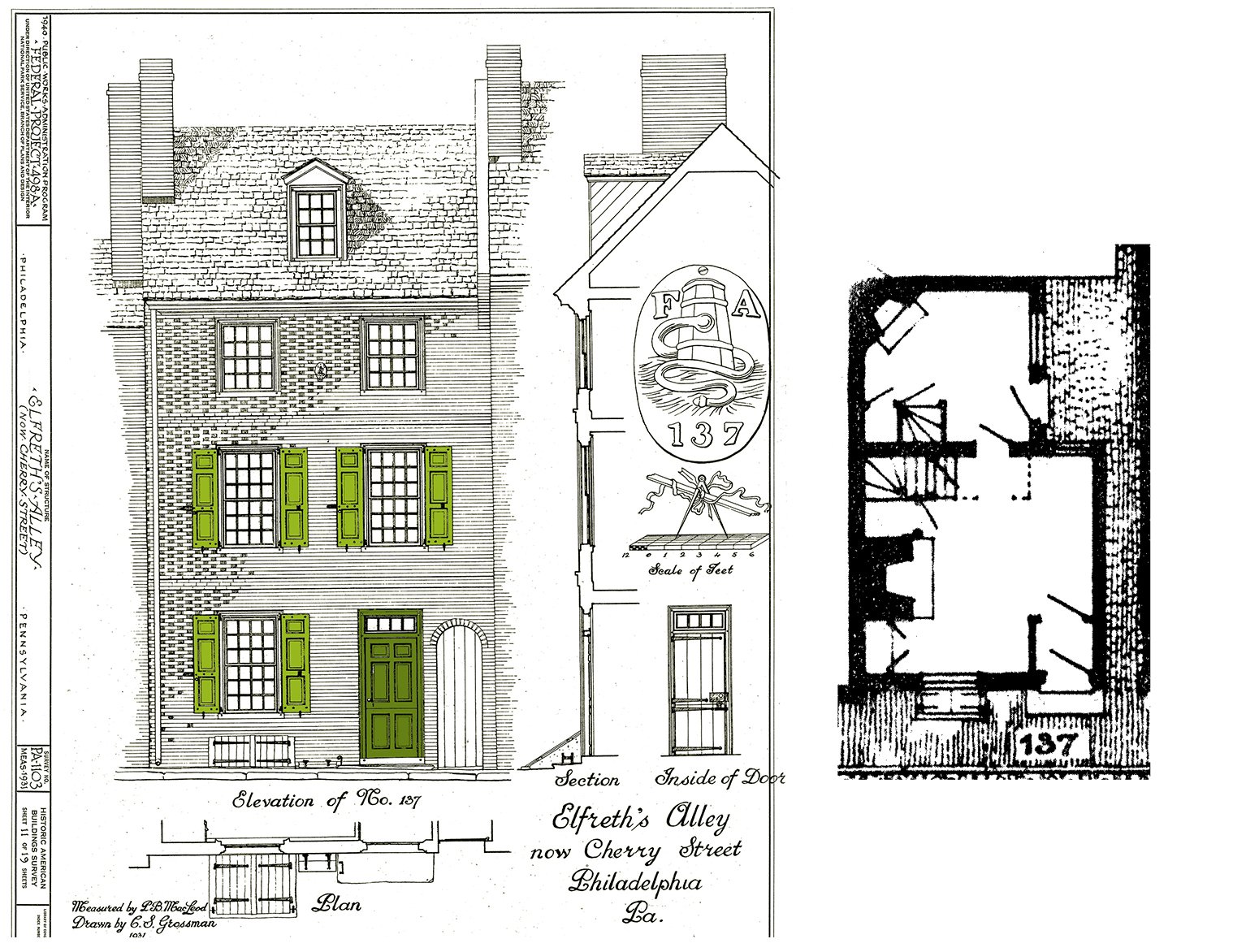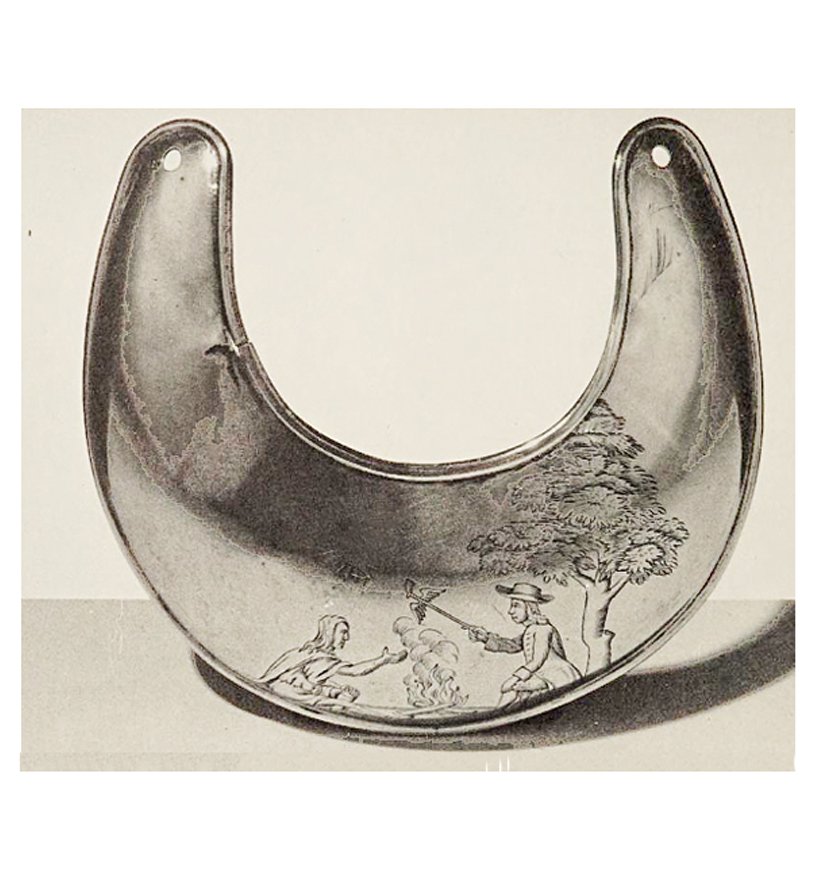Historic Quaker Houses of Philadelphia
Elfreth House
137 Elfreth Alley
Built 1789
Above: Elfreth House on right with green shutters, at 137 Elfreth’s Alley, Philadelphia. Built for Hannah (Trotter) Elfreth, widow of silversmith Jeremiah Elfreth, Jr. Image source: Lee J. Stoltzfus.
Philadelphia’s Elfreth Alley is one of the oldest continuously inhabited residential streets in the U. S. The alley is lined with an exceptional collection of rowhouses built between 1720 and 1836. This neighborhood has an early history with the Elfreth family, who were prominent Quakers.
The Elfreth House at 137 Elfreth Alley was built in 1789 by cabinetmaker Josiah Elfreth (1759 - 1793) for his widowed mother Hannah (Trotter) Elfreth (1729 - 1791). She was the widow of silversmith Jeremiah Elfreth, Jr (1723 - 1765).
Cabinetmaker Josiah Elfreth was a primary developer of Elfreth’s Alley. He built many houses here for investment as rentals or resale. The alley is named for his grandfather, blacksmith Jeremiah Elfred, Sr. (1692 - 1772) who owned several properties here.
1939: Drawings of Elfeth’s Alley
For the Historic American Buildings Survey:
Above and below: Architect P. B. Maclead drafted measured drawings of houses on Elfreth’s Alley for HABS. The drawings were published in 1940 by the Public Works Administration. Image source: Library of Congress. Green label added.
Three-Story Trinity Houses
The Philly Cheesesteak of Vernacular Architecture:
Image source: Image source: Library of Congress. Digital color added.
Above: Trinity houses are icons of Philadelphia’s architectural history. The name “trinity house” derives from the houses’ tripartite form: three small rooms, three stories high. This Elfreth house is a modified trinity house. It is a a three-story rowhouse, with a one-room main block and an extension to the rear.
Trinity houses are known for their small size and winder staircases. These houses are often located in alleys behind main streets. Trinity houses are like Philly cheeseteaks; they are a signature of the city.
The House Description in
Philadelphia Register of Historic Places:
Image source, above: Philadelphia Register of Historic Places
Elfreth’s Alley Photograph by Stacey Granger:
Above: Elfreth’s Alley photograph by Stacey Granger.
Silver by Silversmith / Goldsmith Jeremiah Elfreth, Jr.
This was the home of his widowed mother and family.
Above: Silver by Jeremiah Elfreth, Jr.
Left: Sugar nips, ca 1750 - 1760. Image source: Philadelphia Museum of Art.
Right: Silver creamer with mask-headed feet, ca. 1750. Image source: Sotheby’s
Elfreth Silver in the Elfreth House
Made by Jeremiah Elfreth, Jr for his Family:
Image source: Early American Silver and its Makers, article by Carl M. Williams, 1979. Internet Archive
Peace Offerings for American Indians
By Jeremiah Elfreth’s Apprenticeship Master:
Quaker Silversmith Joseph Richardson, Sr.
Above: Silver peace medal struck by silversmith Joseph Richardson, Sr. in 1757. Image source: Library Company of Philadelphia.
Above: Silver gorget by Joseph Richardson, Sr., ca. 1760, for presentation to Native leaders from the Quaker’s Friendly Association. Image source: Joseph Richardson and Family, Martha Fales,1974. Internet Archive
In the 1740s young Jeremiah Elfreth Jr. learned silversmithing as an apprentice to Quaker silversmith Joseph Richardson, Sr. who later crafted the peace medals shown above.
This 1757 medal (above left) was the first peace medal made in America. It depicts a Quaker holding a peace pipe at a council fire with an American Indian.
The medal was commissioned by wealthy Pennsylvania Quakers who attempted to mediate negotiations between Delaware Indians and the Pennsylvania Assembly during the French and Indian War. This Quaker group, the Friendly Association, distributed these medals to the Native Americans as tokens of goodwill.
Philadelphia Quakers founded his organization as the “Friendly Association for Regaining and Preserving Peace with the Indians by Pacific Measures,” a. k. a. the “Friendly Association.”
Silversmith Joseph Richardson, Sr. lent money to this cause. He made thousands of silver objects to present to the Native leaders, including arm bands, gorgets, ear bobs, rings, etc.
Philadelphia Quaker Silversmiths:
Silver Peace Medals are Good.
Silver Sword Hilts are Bad.
Above left: George Washington's 1753 silver-hilted smallsword which he carried during the French and Indian War. (London)
Above right: George Washington's 1767 silver-hilted smallsword. (London) Images source: MountVernon.org
Philadelphia Quaker silversmiths advocated for peace, instead of fighting for revolution. Many of those anti-war silversmiths declined to make silver sword hilts. They refused to compromise their peace testimony.
More than 100 other American smiths made silver hilts for swords. But members of the Society of Friends typically did not. Silver historians presume that Joseph Richardson, Sr. made no sword hilts.
A grandson of silversmith Jeremiah Elfreth Jr. was historian Jacob R. Elfreth (1789 - 1870). He compiled an Elfreth family history published in 1902 as The Elfreth Necrology. The book’s preface explains that this Elfreth historian was a peace-loving Friend and no friend of swords.
But Jacob’s brother, Joseph Elfreth, turned away from his Quaker pacifism and became an officer in the War of 1812. Joseph left his sword to his historian brother Jacob, who “being a plain Friend, and consequently a man of peace, broke it into three pieces.” Hopefully it wasn’t a George Washington sword.
Elfreth’s Alley Links:










